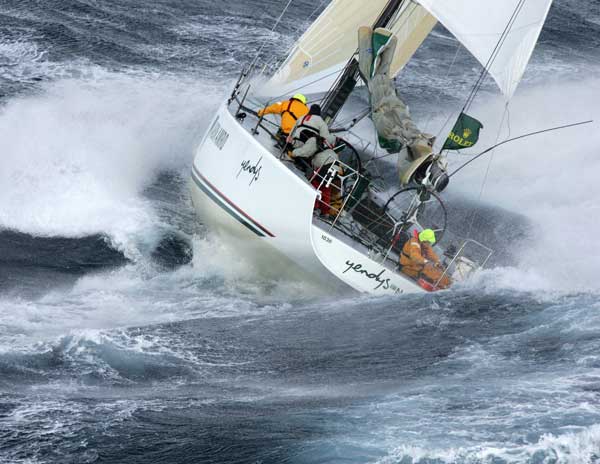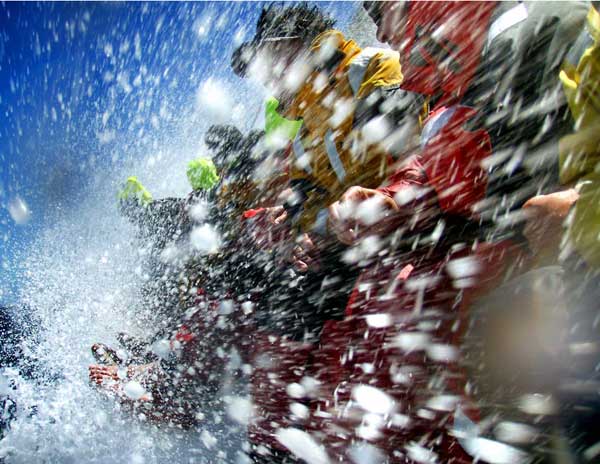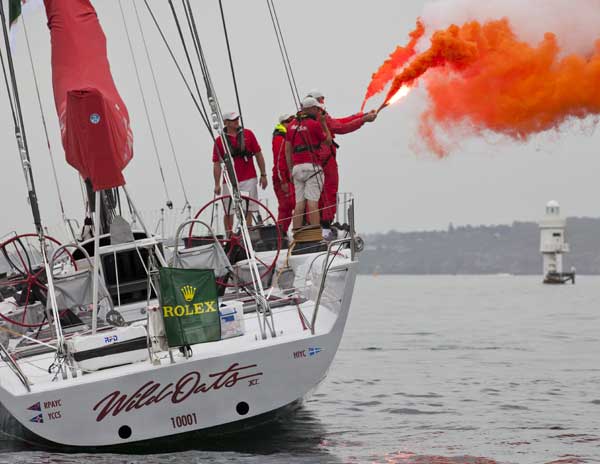
photo Daniel Forster Rolex
By Jim Gale, Rolex Sydney Hobart media team
After several years of mostly tactical racing in comparatively benign conditions, the 2010 Rolex Sydney Hobart is set to return to its more traditional ways, with competitors told today that they are in for some very tough, boat and spirit-breaking sailing for at least the first 300 nautical miles of the race.
The Bureau of Meteorology has predicted that early in the race the fleet will strike a southerly change on the New South Wales coast, and by early Sunday evening the winds will have built to between 20 and 30 knots.
Blessedly the current will not be a fast as in recent years, so the waves will not be so steep, but in the cantankerous seas off the east coast, where waves seem to bounce back off the continent and come at you from a host of different angles, it will make for a cold night on a bucking bronco of a boat, the crew perched on the perpetually drenching rail.
“It is going to be pretty tough going,” says the Bureau’s regional director NSW Barry Hanstrum. “There is very little indication of any downwind sailing.”

photo Daniel Forster Rolex
Indeed on Monday a low pressure area pushing below Tasmania will reinforce the first southerly. As the front runners launch across Bass Strait they are expected to plunge into 30 to 40 knot headwinds and 4 to 5 metre seas.
After battling across the Strait the yachts will then have to deal with fickle winds on the lee of Tasmania, becoming more fickle as the yachts move down the coast, while the boats behind them continue to see fresh winds, potentially swinging towards the west to give them a chance to fast reach.
With this forecast you can forget about race records, says Ian Burns, co-navigator of line honours favourite Wild Oats XI. He thinks that for the first 300 nautical miles of the race they will be trying to slow the 100 foot maxi down, to keep her in one piece.
”The real challenge of the first couple of nights will be keeping the boat together. We’ll be slowing down rather than necessarily trying to break any records or break our opposition. We just want to be sure we don’t break ourselves.”
Burns thinks Wild Oats XI could take up to two and a half days to reach Hobart, almost a day longer than her 2005 record pace of 1 day 18 hours and 40 minutes.
The southerlies will be a great equalizer in the dash for line honours. In a race to windward in flat seas there is no doubt Wild Oats XI holds a clear advantage over her heavier rivals, Investec Loyal, Lahana, YuuZoo and Brindabella, but with everyone resorting to two, and sometimes three reefs in their sails, this will be no flat-water sprint.
The front runners will be much more bunched, and Matt Allen, in his Volvo 70 Ichi Ban has been waiting for these conditions for years. This is just what his round-the-world racer was built for.
For every skipper the challenge will be the same for the first 48 hours; don’t break the boat, and somehow keep the crew rested enough, well fed enough, warm enough, so that when the time for intense tactical racing down the Tasmania east coast falls due on Tuesday and Wednesday they are completely switched on.
Bryan Northcote, navigator on Syd Fisher’s TP52 Ragamuffin, believes the navigators won’t have much to contribute those first 300 miles. The weather will decide what the boats do and where they go. But the second 300 miles will be where the tacticians and navigators shine.
“This will be a race in two parts,” he says. “The first 36 hours will be about who manages their boat best, and the second 36 hours will come down to the navigators. The vagaries of the wind off Tasmania will make for interesting times late Tuesday and Wednesday morning. That is when the race will be won or lost.”
And at this stage this does seem to be a forecast that favours the grand prix boats in the mid range. Denied the chance to fast reach down New South Wales, the maxis won’t be able to burn off the grand prix boats in the first 24 hours, and the maxis do need to open a gap early to overcome their big handicap rating.
The 50 and 60 foot range is where the boats are most evenly matched, many crewed by the cream of international professional yachting. The crew that does best in this second half of the race will need to get every ounce of speed out of their boats every minute of the day, no matter how tired they are, and then they will have to pick exactly the right part of the course to be in when the wind shifts, and choose precisely the right angle to steer into Tasman Island before the breeze closes down on the notoriously heartbreaking Derwent River.
Tuesday and Wednesday promise vintage cat and mouse Rolex Sydney Hobart racing.
While the current long range forecast would appear to favor the 50 and 60 footers this year, five days is a long time in the weather business. The timing of fronts, the wind coming in at just that slightly different angle can open everything up. Niklas Zennstrom’s crack 72 foot Rán will not need much of an opening to put enough between itself and the highly fancied 62 footers Limit and Loki to snatch the trophy, and while the 50s and 60s are slogging it out in fickle winds off Tasmania, the 40 foot plus yachts will still be in plenty of breeze back in Bass Strait, hoping that by the time they see Tasmania the wind there will have freshened.
It is still too far out for the weather models to tell us much about what will happen after late Wednesday. Will the wind swing right round to the north west on Thursday, blasting the tail enders home and turning this year’s Rolex Sydney Hobart into one for the littlies? Will it stay on the nose, favouring the older, IOR style of yacht that was designed to claw its way to windward and to hell with fast reaching? That’s what it did in 2006, when the Tattersall’s Cup was carried off by the veteran Love & War after skipper Lindsay May delivered a master class in exploiting the currents.
“I’d put my hard earned on the boats just a little above the middle of the fleet” is the how CYCA Commodore Garry Linacre puts it, “but some of the older boats that have a very strong accent in the IRC ratings towards windward work will be worth having a good look at. Boats like Spirit of Koomooloo, that sort of boat.”

Wild Oats XI crew firing distress flares during their safety exercise in Rose Bay. photo Daniel Forster Rolex
For now though, all we know for certain is that the first two days will test the mettle of every crewmember and every yacht in the fleet. No one can win if they cannot survive those first days intact.
For the front runners the task will be keeping their speed machines on the leash for the first half of the race. For the small boats, the opening days will be no more than round one in a long, demanding marathon.
Jonathon Stone, the skipper of the smallest boat in the fleet, the Davidson 34 Illusion, actually has no illusions at all.
“We have sailed in these conditions before,” Stone says. “I won’t say I’m looking forward to it, but we’ll do it.”